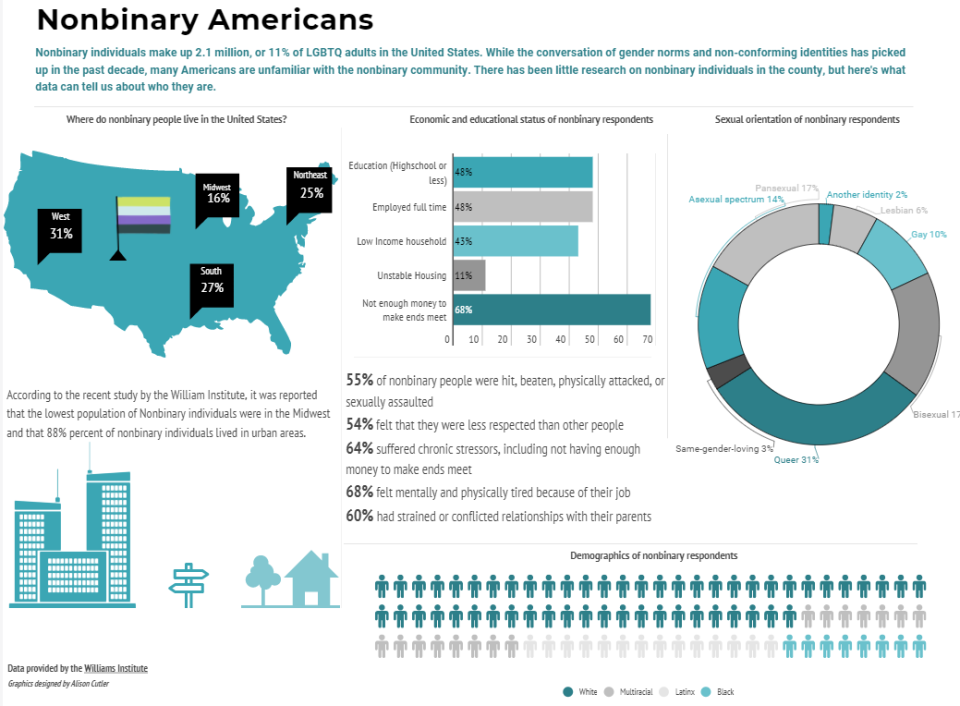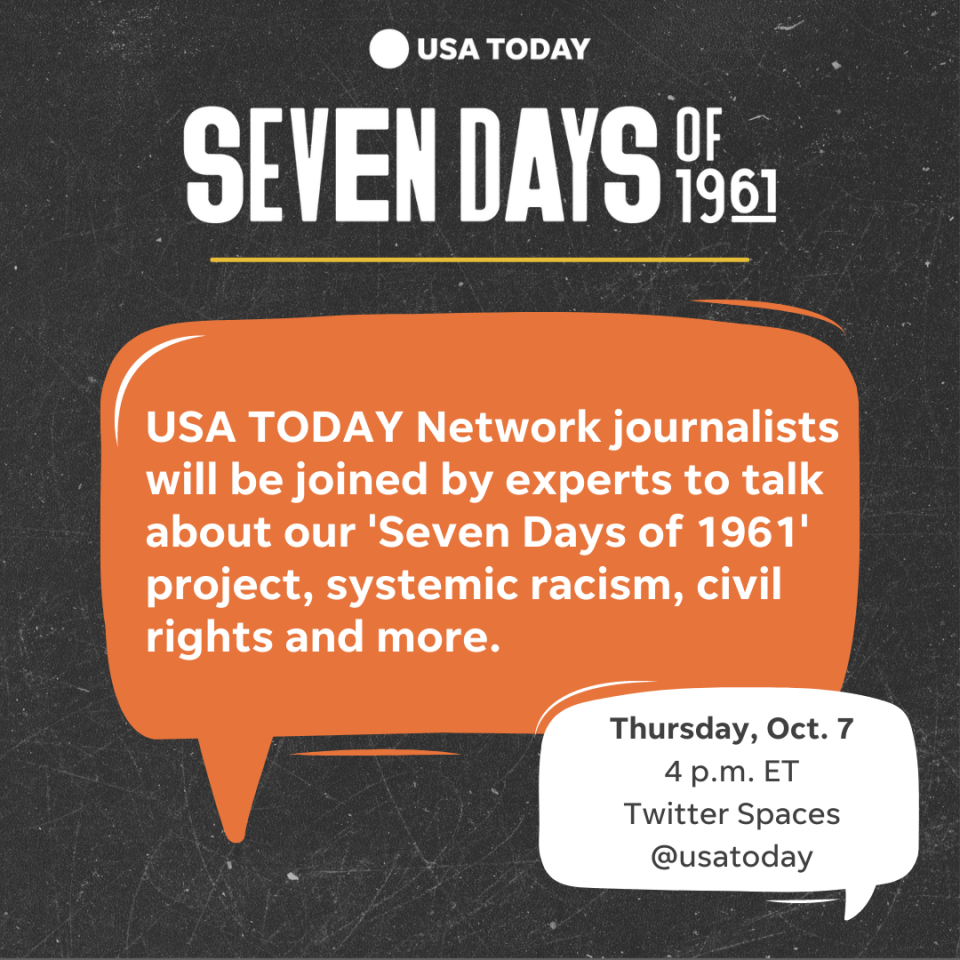This is America: How society's views on gender impact relationships
Nonbinary Americans' love stories are largely untold. Between the pages of non-gender conforming romance, members of the community also share accounts of body dysmorphia, inequality and consuming societal norms.
Hello everyone! I’m Petruce Jean-Charles, a government watchdog reporter in Asheboro, North Carolina. As a nonbinary individual, conversations about how I wish to present and what I want for future relationships always come up.
With the help of Alison Cutler, a government watchdog reporter in Staunton, Virginia, we look at society’s impact on nonbinary and gender nonconforming identities.
For this edition of This is America, two nonbinary people opened up about their journeys in relationships and finding their identities, a narrative that is largely unfamiliar and under-researched in a country that continues to diversify with time.
But first: Race and justice news we're watching
Important stories of the past week, from USA TODAY and other news sources.
How Lil Nas X, Lena Waithe and 'Sex Education' are championing Black, queer love stories
Seven Days of 1961: It was the ‘deadliest place’ for Black people in the US. That didn’t stop these high school students from changing history.
Seven Days of 1961: They held a ‘read-in’ at a whites-only library in 1961 and helped end segregation. Meet the Tougaloo Nine.
Seven Days of 1961: Freedom Riders traveled deep into the South in 1961. Klansmen beat them, then set their bus on fire.
Democrats said they were all in on Black colleges. So why doesn't Biden's bill do more for HBCUs?
Gender conformity and societal pressure
Nonbinary individuals make up about 11% of the adult LGBTQ community in America, totaling 1.2 million people in the country, according to a recent study.
Genny Beemyn is the director of the Stonewall Center at UMass and has felt the pressure of gender conformity ever since they were young. For much of their youth, America’s visibly cis society wasn’t a puzzle that Beemyn fit into. The societal expectations stretched beyond offhand comments at parties or public pressure to look a certain way. Eventually, it began to bleed into their personal lives and impact relationships.
“I can speak a lot to this, having a difficult time finding relationships,” Beemyn said. “Even people who may color outside the lines of sexuality still have very gendered expectations of someone who’s assigned male or female, and has issues with someone who is nonbinary."

While a fair amount of research about identity and relationships has been conducted on other groups in the LGBTQ community, including those who are gay, lesbian and transgender, the nonbinary community is much less prominent in peer reviewed research. In addition, articles often refer to statistics about transgender people when referring to nonbinary individuals.
Read more: Census Bureau’s first ever data on LGBTQ people indicates deep disparities
An evolving understanding of identity
Since there is a lack of historical context and research on nonbinary people, here are some facts to know about the gender identity.
Almost half of America isn't familiar with gender neutral pronouns, according to a recent Pew Research Poll.
Nevada now joins D.C., Arkansas, California, Colorado, Indiana, Maine, Minnesota, Oregon, Utah and Vermont in permitting gender-neutral driver’s licenses and other state IDs.
Gender-neutral birth certificates are now permitted in New York City and several states, including California, Nevada, New Jersey, Oregon and Washington.
According to research, America has been statistically reluctant to accept gender deviation from cis people. Other countries have already embraced moving toward gender-neutral references in society, including Canada and Sweden, which adopted the term "hen" when "han" refers to a man and "hon" refers to a woman.
In the mid-'90s, Beemyn said people started talking about gender and how to use pronouns such as ze and hir. Beemyn started using those pronouns but knew that if it was new to them, the rest of society would not know either, and had to constantly educate.
It would not be until after a few years, that Beemyn would switch to they/them because the language had caught on in society. However, one thing that did not catch on was the comfortability to date people outside of the gender binary.
Beemyn said they met someone online who said she would not be comfortable referring to them as they/them or introducing them to her family using those pronouns. “This person after this ended up dating a trans guy so it wasn’t a rejection of trans people per se, it was a rejection of nonbinary people," Beemyn said.
According to Jane Fleishman, a sex researcher who works in marginalized LGBTQ communities, there also are people who stigmatize on dating sites because they fetishize the person’s body.
As a lesbian, she has read the research of nonbinary individuals such as Lucie Fielding, to understand dating issues. Fielding is a nonbinary trans femme therapist who did an analysis about what it is like to be transgender or nonbinary today. Their analysis found there are a lot of people frightened by dating because there is so much stigma and violence against the community.
Fleishman further believes it is important to look at the historical figures of sexual orientation and gender such as Karl Heinrich Ulrichs, Karl-Maria Kerbeny and Richard von Krafft-Ebing who opened conversation about identity and sexual orientation.
TikTok and pop culture join the conversation
Recently there has been more conversation about gender on social media platforms such as TikTok. Sarah Hutchings, operations analyst at USA TODAY, said they feel TikTok is giving more exposure to different gender identities, while educating people at the same time. They also have seen videos that tackle issues with dating and relationships.
“On ‘Sex Education’ there is a black nonbinary character who made it a point to tell their cisgender boyfriend that they are a queer nonbinary person and so he would fundamentally experience the relationship differently than if they were a cisgender woman,” Hutchings said.
When starting new relationships, Hutchings is often worried about violence because they have been put in uncomfortable situations. "While I have experienced discrimination, I often tell other middle class white trans people that they don't have to worry about violence as much as it is exacerbated at the intersection of gender, race, and class.”
Hutchings grew up in a conservative family and was not taught about transgender people growing up, which led to confusion and dysphoria. They felt fortunate to have a nonbinary person as a manager in 2013 because the atmosphere was welcoming. Despite losing some family and friends, they found community and now identified themself as nonbinary.
"I get read a lot as an assigned female at birth nonbinary person now. It’s a very different experience of being nonbinary, than when I was in 2013.”
Hutchings understands how different gender identities can be confusing and advises people not to push education down people’s throats. They also advise against letting education take over personalities because at the end of the day, there will always be more to learn when it comes to gender identity.
Join us in Spaces

Join our journalists as well as experts in a Twitter Spaces on Thursday at 4 p.m. ET about our "Seven Days of 1961" series, how the year changed American history and how it affects us today. https://twitter.com/i/spaces/1djxXPeMazBxZ
--
This is America is a weekly take on current events from a rotating panel of USA TODAY Network journalists with diverse backgrounds and viewpoints. If you're seeing this newsletter online or someone forwarded it to you, you can subscribe here. If you have feedback for us, we'd love for you to drop it here.
This article originally appeared on USA TODAY: Society's views and their impact on nonbinary relationships

 Yahoo Sports
Yahoo Sports 